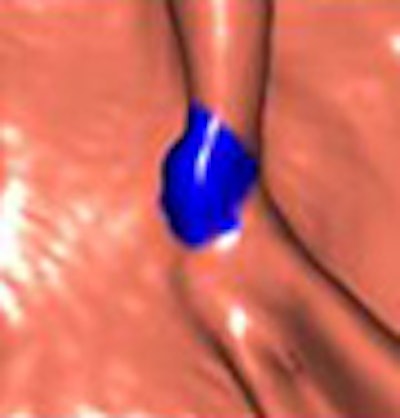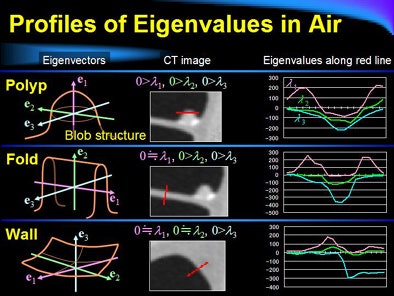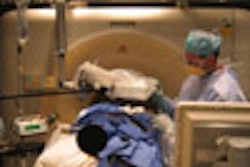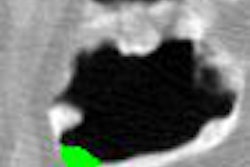
BERLIN - Virtual colonoscopy computer-aided detection (CAD) schemes based on the Hessian matrix method are gaining currency among researchers.
Some consider Hessian matrix-based algorithms to be more flexible and potentially more sensitive than shape-based detection schemes because they are not limited to a few standard forms like curves in their search for colorectal polyps. Rather, any "blob" could potentially be a polyp candidate if its CT values and relative location to other structures fit a profile.
Intensity value analysis used as an initial detection step is also compatible with reduced colonic preparation and fecal tagging, which are becoming important components of the reduced prep VC exams that are easier for patients to endure.
At the 2007 Computer Assisted Radiology and Surgery (CARS) conference, doctoral student Masahiro Oda presented a CAD study that used filters based on Hessian matrix eigenvalues to eliminate false-positive polyp candidates, and CT intensity values for initial detection.
"The purpose of our study was development of a polyp detection method from 3D abdominal CT images based on local intensity structure analysis," Oda said. His colleagues included Yuichi Nakada, Takayuki Kitasaka, Kensaku Mori, and Yasuhito Suenaga from the Graduate School of Information Science at the University of Nagoya in Japan, along with colleagues from Sapporo Medical University, Sapporo-Minami-Sanjo Hospital, and Sapporo Kosei General Hospital in Sapporo, Japan.
The CT values of polyps on the colon wall are higher than those of colonic lumen regions, and lower than those of tagged fecal materials, the group explained in an abstract. And attenuation changes depending on the surrounding environment in the colon.
"CT values inside polyps existing outside the tagged fecal materials tend to gradually increase from outward to inward (blob-like structure)," they wrote. "CT values inside polyps existing inside the tagged fecal materials tend to gradually increase from outward to inward (inverted blob-like structure)."
 |
| All graphics and images courtesy of Masahiro Oda and Kensaku Mori. |
"We employed blob and inv-blob structure enhancement filters based on eigenvalues of Hessian matrix," Oda explained.
The process begins with extraction of the colonic wall. Gaussian smoothing filters are applied to the CT images, then the blob and inv-blob structures are detected. The two false-positive filters eliminate small components and low-value components in succession, leaving the remaining polyp candidates for evaluation by the radiologist.
 |
| In the intensity-based CAD scheme, the local intensity structure on the CT images is approximated by fitting the surface to the neighborhood of each voxel. The Hessian matrix is then calculated using the partial second derivatives of the fit surface. The eigenvalues of the Hessian matrix correspond to the maximum and minimum values of the second derivatives. Eigenvalue profiles are distinct depending on whether the structures are in air/lumen regions (above) or tagged fecal material (below), generating distinct output on the blob enhancement filter inv-blob enhancement filters used to cull false-positive detections. The output of these two filters is applied to the CT images. |
 |
The enhancement filters work by eliminating small connected components (such as polyps smaller than 5 mm) and connected components with low voxel values, Oda said.
Reduced-prep virtual colonoscopy datasets with known polyps were supplied by Dr. Richard Choi from the Walter Reed Army Medical Center in Washington, DC. They were acquired using a 512 x 512 matrix, 120 kVp, 200-300 mAs, 1.25-mm slice thickness, and reconstructions of 1 mm.
"We applied the proposed method to 104 cases of abdominal CT images," Oda said. There were a total of 57 polyps 6 mm or larger in the images, including 46 in air and 11 in the tagged fecal material.
According to the results, sensitivity was 89.1% in air and 90.9% in tagged fecal material, with a mean 14.1 false positives per case (much improved from 32 false positives per case before application of the enhancement filters).
"The method detects polyps with high sensitivity with low false-positive numbers," Oda concluded. The CAD scheme was able to detect polyps in both the air and tagged regions without need of digital bowel cleansing, and the filters enhanced polyps effectively, he said.
Since the system picks polyp candidates from blobs and inverted blobs, it does not detect flat polyps, and a method will need to be devised in future versions to accomplish this, the authors wrote in their abstract.
According to Oda, many of the false-positive detections consisted of convex-shaped objects, including ileocecal valves and catheter tips commonly read by CAD systems as polyps. New features are needed to classify polyp candidates into true positives and false positives. "And more data and multicenter trials," he said.
By Eric Barnes
AuntMinnie.com staff writer
July 2, 2007
Related Reading
CARS news: USC group develops home-grown CAD-PACS integration toolkit, June 29, 2007
Fully automated VC CAD system solves tagging problems, June 25, 2007
Noncathartic bowel prep facilitates, complicates virtual colonoscopy, June 15, 2007
VC CAD ramps up detection of medium-sized polyps, March 12, 2007
CAD struggles through tagged, subtracted VC data, May 18, 2005
Copyright © 2007 AuntMinnie.com




















